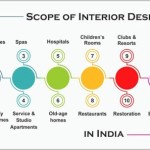How Much Do Interior Designers Make in NYC?
New York City, a global hub for design and innovation, presents a dynamic and competitive landscape for interior designers. Understanding the compensation structures for these professionals is crucial for those considering a career in this field, as well as for established designers seeking to benchmark their earning potential. This article will delve into the various factors influencing the salaries of interior designers in NYC, providing a comprehensive overview of income expectations based on experience, specialization, and the type of firm employing them.
The compensation for an interior designer in New York City is not a fixed value. It's determined by a complex interplay of elements, including the designer's level of experience, the specific area of specialization within interior design, the type and size of the company they work for, their educational background and credentials, and the overall economic climate of the city and the design industry. This article will unpack these elements in detail, offering insights into typical salary ranges and the potential for growth within the field.
Experience Level and Salary Progression
Experience is a primary driver of earning potential in any profession, and interior design in NYC is no exception. Entry-level positions, often designated as junior designers or design assistants, typically command lower salaries compared to those held by designers with several years of experience and a proven track record. These entry-level roles serve as a crucial training ground, allowing individuals to develop their skills, build a portfolio, and gain a firm understanding of the design process.
Generally, an entry-level interior designer in NYC with 0-2 years of experience can expect to earn a salary ranging from $45,000 to $60,000 annually. This figure may vary slightly depending on the specific responsibilities of the role and the size of the firm. Larger, more established firms often offer slightly higher starting salaries, while smaller firms or startups may offer lower base pay but potentially greater opportunities for rapid growth and advancement.
As designers accumulate experience, their earning potential increases significantly. Mid-level interior designers with 3-5 years of experience can expect to see their salaries rise to between $60,000 and $85,000 per year. At this stage, designers are typically taking on more responsibility for project management, client communication, and design development. They are also likely to be contributing more directly to the firm's revenue generation.
Senior interior designers, with 5+ years of experience, often command salaries exceeding $85,000 and can reach well over $120,000 per year, or even higher in certain instances. These seasoned professionals are typically responsible for leading design teams, managing large-scale projects, cultivating client relationships, and contributing to the overall strategic direction of the firm. They often possess specialized expertise in a particular area of design and may have a strong reputation within the industry.
The progression of salary with experience is not always linear. It depends significantly on an individual's performance, the types of projects they have worked on, their ability to attract and retain clients, and their overall contribution to the firm's success. Continuous learning and professional development, such as obtaining certifications or pursuing advanced degrees, can also accelerate salary growth.
Specialization and its Impact on Earning Potential
Interior design encompasses a broad spectrum of specializations, each with its own unique demands and skill sets. Certain specializations are inherently more lucrative than others, reflecting the level of expertise required and the demand for those specific services within the New York City market. The specialization an interior designer chooses can significantly influence their earning potential.
For instance, designers specializing in high-end residential design often command higher fees than those focusing on commercial or retail design. This is due to the complex demands of luxury residential projects, which often involve intricate detailing, custom fabrication, and a high level of client service. They regularly work with bigger budgets and more demanding clients often in the high-net-worth sector.
Corporate interior design, which involves creating functional and aesthetically pleasing workspaces for businesses, can also be a lucrative specialization. Companies are increasingly recognizing the importance of well-designed office environments for employee productivity and well-being, driving demand for skilled corporate interior designers. These projects often are also larger in scope.
Healthcare interior design, a rapidly growing field, focuses on creating healing and supportive environments for patients and staff in hospitals, clinics, and other healthcare facilities. This specialization requires a deep understanding of healthcare regulations, accessibility standards, and the psychological impact of design on patient outcomes. As the healthcare industry emphasizes patient-centered care, the demand for specialized healthcare interior designers is projected to increase.
Sustainability is becoming increasingly important in the design field. Interior designers with expertise in sustainable design principles and certifications such as LEED (Leadership in Energy and Environmental Design) are becoming highly sought after. Clients are becoming more environmentally conscious, driving the demand for sustainable design.
The earning potential within each specialization is also influenced by the specific niche within that area. For example, a hospitality interior designer specializing in luxury hotels might earn more than one focusing on budget-friendly motels. A designer focusing on high-end tenant improvements for corporate clients might earn more than one focusing on creating common areas for apartment buildings. The earning potential depends not only on the sector, but also on the designer’s niche with that sector.
Firm Type, Size, and Location
The type and size of the interior design firm employing a designer play a significant role in determining their salary. Larger, more established firms with a diverse portfolio of high-profile projects typically offer higher salaries and benefits packages than smaller firms or freelance positions. This is due to their greater financial resources, more complex organizational structure, and the ability to take on larger and more lucrative projects.
Working for a large, international design firm can provide opportunities for career advancement and exposure to a wider range of projects and clients. These firms often have established training programs and mentorship opportunities, allowing designers to develop their skills and expertise. However, they may also have a more bureaucratic structure and require designers to work on specialized tasks within a larger project team.
Smaller firms, on the other hand, may offer a more intimate and collaborative work environment, with designers having the opportunity to work on all aspects of a project from concept to completion. This can be a valuable experience for designers who are looking to develop their skills and gain a broad understanding of the design process. However, smaller firms may have limited resources and offer lower salaries and benefits.
Freelance interior designers operate independently and are responsible for managing their own businesses, including marketing, client acquisition, and project management. While freelance work can offer greater flexibility and control over one's career, it also comes with the responsibility of generating one's own income and managing all business-related expenses. The earning potential for freelance designers can vary greatly depending on their experience, reputation, and ability to attract and retain clients.
The location of the firm within New York City can also influence salaries. Firms located in more affluent areas, such as Manhattan, may offer slightly higher salaries to compensate for the higher cost of living. Additionally, firms that specialize in serving high-end clients in these areas may be able to command higher fees, allowing them to pay their employees more competitive salaries.
Furthermore, the economic health of the entire city and the design industry more generally have a significant impact. During economic downturns the design industry may experience periods of less demand, leading to lower salaries or even potential layoffs. During periods of economic growth, the reverse is true.
In summary, the salary of an interior designer in NYC is highly variable and depends on a collection of factors, with experience, specialization, and firm characteristics being primary considerations. Understanding these factors is crucial for both aspiring and experienced designers alike in navigating the competitive landscape of the New York City design industry.

How Much Does An Interior Designer Cost In 2024 Forbes Home

The Best Of Usa A Top 20 Nyc Interior Designers

How Much Does An Interior Designer Cost In 2024 Decorilla Design

The Best Of Usa Top 20 Nyc Interior Designers

Interior Designers The Nyc Top 20 Daily Design News

Top Nyc Interior Designers Our Selection Esperiri Milano

How Much Does An Interior Designer Cost In 2024 Decorilla Design

2024 Interior Designer Costs Charges Hourly Rates Fees To Hire

How Much Does An Interior Designer Cost In 2024 Decorilla Design

Interior Designer Long Island Ny Nyc
Related Posts








